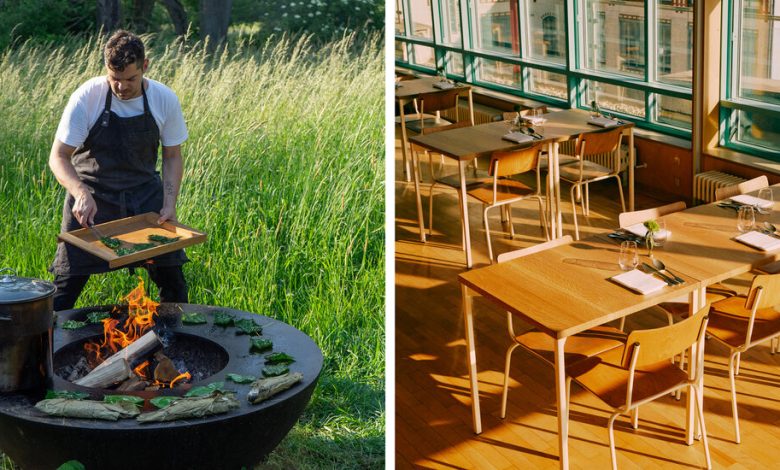In Berlin, a Summer of Open-Fire Cooking

Eat Here
A Set of Restaurants Making Fire-Grilled Fare

Left: Etienne Kiefer, a founder of Woodcuisine, cooking on the Feuerring, a fire ring created by the Swiss artist Andreas Reichlin. Right: the interior of the restaurant Ember, which opened this spring in Berlin.Credit…Left: courtesy of Woodcuisine. Right: Jose Cuevas
By Gisela Williams
Whether in a field or atop a building, more and more Berlin chefs seem to be cooking over open fires. At Kramer Restaurant, in the lively Kreuzkölln neighborhood as of January, an open-fire grill is front and center; those who book the chef’s table can observe cooks expertly singeing steak, fish and seasonal vegetables. The founder, Fabian Kramer, also works with fire to produce the artisanal ceramic vessels that decorate the space. Mischa Amadeus Olma, a founder of Woodcuisine, arranges foraging workshops and dinners outdoors (currently in an herb garden in the leafy Mariendorf neighborhood) where he and friends offer a changing menu — one evening it was fire-grilled trout and a dessert of pancakes served with freshly foraged honeycomb — that is cooked on the sides of a steel fire ring forged by the Swiss sculptor Andreas Reichlin. Jeffrey Claudio (who has cooked at the Singapore restaurant Burnt Ends) and his partner, Jessica Tan, have opened a temporary rooftop yakitori restaurant — a tiny wood house with a dozen seats around a grill. Their permanent restaurant, Stoke, is scheduled to open next year. Ember, which started service in May, is also located on a rooftop, in a room with walls of glass and a terrace where the outdoor kitchen is located. It’s overseen by Tobias Beck, who trained with the Argentine chef Francis Mallmann. He serves up a four-course menu for 68 euros from Thursdays through Saturdays, which might include wood-fired ricotta with fava beans and salted lemon or lamb al asador.
Stay Here
A New Hotel in a 13th-Century Spanish Palace
By Siobhan Reid
When José Polo and Toño Pérez opened their restaurant Atrio in Cáceres, a city in Spain’s sparsely populated western Extremadura region, neither one had worked in a restaurant before. But they loved to entertain and dreamed of putting their hometown on the culinary map. Three decades later, Atrio was awarded its third Michelin star last year. Now, the couple have opened an art-filled hotel — their second in Cáceres — within a 13th-century palace across the street from the restaurant. Emilio Tuñón, the winner of Spain’s 2022 National Award for Architecture, and his architectural partner, Carlos Martínez Albornoz, set about modernizing the palace while preserving as many historic details as possible. As part of the restoration, the building’s imposing tower, which was ordered to be lowered in the 15th century by Queen Isabella I, has been rebuilt to its original height. The 11 rooms of Casa Palacio Paredes-Saavedra are outfitted with hand-carved marble bathtubs and luxurious extras ranging from fireplaces and grand pianos to private terraces. In the common spaces, the vaulted ceilings, Renaissance archways and Mudéjar mullioned windows serve as a backdrop for Polo and Pérez’s art collection, which includes 80 lithographs from Francisco Goya’s “Los Caprichos” series. Guests can head next door to Restaurante Torre de Sande, also owned by the couple, for casual regional fare. They also plan to open a music school on nearby Plaza Santa María with free classes for children. “We want Cáceres to be a Florence, a Rome, where everyone can have access to all the beauty and art,” says Polo. From about $1,195 a night, restauranteatrio.com.
Visit This
A Centuries-Old Confectioner’s Milan Cafe
By Laura May Todd
Italy’s oldest confectionery, Romanengo, was founded in the port town Genoa in 1780. At the time, the city’s harbor was among the world’s most trafficked. Merchant vessels from the Middle East would dock alongside ships departing west, mixing cultures as much as they were trading goods. It was here that Antonio Maria Romanengo began selling spices and later candy — made with sugar and recipes brought to Italy following the first crusades in the east — to the local Genovese and passing sailors who believed that, when conserved in sugar, fresh fruit would retain its nutrients on long voyages. Two hundred and 30 years later, preserved apricots, figs, oranges and pears are still on sale in glass-fronted cases in the same port-side storefront the family opened in the mid-1800s. In 2022, Romanengo launched its first Milan outpost, a cafe, sweet shop and spice boutique in the quiet courtyard of a traditional ringhiera building, a uniquely Milanese type of apartment complex defined by shared open balconies ringing each floor, in the Cinque Vie district. The new location trades in the same artisanal delicacies as the original, like biscuits made from raw almond paste, hard candies filled with bursts of liquid flavor, mandarins swollen with sugar syrup and dipped in dark chocolate and slivers of cinnamon sticks, hand-cut and coated with sugar to resemble tiny frostbitten branches. There are also seasonal treats, like ice cream. This summer, you’ll find fior di latte perfumed with orange blossoms or rose petals, with toppings like santé chocolate, spices or candied fruit peel. romanengo.com.
See This
Brigid Berlin’s New York Life and Art, on Display
By Samuel Rutter
Brigid Berlin, a fixture of the downtown art world in the ’60s and ’70s, will be forever associated with Andy Warhol — the Factory superstar played Duchess, a version of herself as a lesbian drug dealer, in Warhol and Paul Morrissey’s 1966 film “Chelsea Girls” — but three years after her death in 2020, a new exhibition considers Berlin’s art in its own right. “Brigid really was an innovator when you think of the way she used persona as a medium,” says Alison M. Gingeras, who has curated “Brigid Berlin: The Heaviest,” at New York’s Vito Schnabel Gallery, which examines the artist’s life, from her tony uptown upbringing to her secluded later life, with the wild times in between. “For too long she has been pushed into the footnotes.” In a room that features the same wallpaper as Berlin’s Murray Hill apartment, visitors can peruse photos and letters from her childhood. (Berlin’s mother, the socialite Honey Berlin, fed her daughter amphetamines to stave off weight gain, a moment the artist revisited later with a wry needlepoint cushion cover that reads: “It is about the weight.”) There are plenty of “tit prints,” painted with the artist’s own breasts, along with the imprints of penises belonging to famous men from the scene at the nightclub Max’s Kansas City. It’s the influence of figures like Robert Rauschenberg, Willem de Kooning and Larry Rivers who give the show its title: From the outset, Gingeras says, they recognized Berlin’s talent and bravura, according her a seat in the front room of the bar with the rest of the “heavies,” even as she also held court in the back with Warhol. Leather-bound albums containing Polaroid portraits of these artists are accompanied by audio selections from the hundreds of cassettes that came from Berlin’s habit of taking a tape recorder with her almost everywhere she went, leaving behind an archive of a vibrant moment in New York’s history. “Brigid Berlin: The Heaviest,” is on view through Aug. 18, vitoschnabel.com.
Stay Here
A Hygge Homestay in Seoul
By Chris Schalkx
Through a narrow passageway in northern Seoul’s Seochon district is a house that, with its clay-tiled gable roof and ornamental wooden rafters, looks no different from its neighbors. Hanok buildings (traditional Korean dwellings) like this are still ubiquitous in the serpentine alleys of the historic district. But inside, the home’s interior is a departure from the typically austere designs of the hanoks next door. Its owners spent summers in a converted barn (a härbre in Swedish) on a secluded Swedish island, and they enlisted the South Korean architecture firm Z_Lab to imbue a deteriorating hanok near their house in Seoul with the hygge feel they had grown fond of. After researching Sweden’s rural architecture and interiors, Z_Lab’s team discovered commonalities between hanoks and härbres: “They both rely on timber structures, exude a modest and warm ambience and integrate harmoniously with their environments,” says Noh Kyung Rok, co-founder of Z_Lab. The home, which is now available for rent on a nightly basis through Z_Lab’s hospitality offshoot, Stayfolio, has an L-shaped floor plan that’s divided into a dining room and a bedroom, partitioned by an open-shelved cabinet and furnished with vintage pieces from Denmark. The blue-yellow color scheme, reflected in the bespoke kitchen cabinets and ceramics by the Copenhagen-based company Raawii, nods to the Swedish flag, while botanical wallpaper designed by Josef Frank for the Swedish interior brand Svenskt Tenn in the 1940s wraps the bedroom in eye-popping colors. From $259 a night, stayfolio.com.
From T’s Instagram
A New Line of Subtle, Glamorous Clothes




